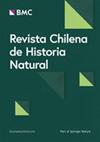墨西哥塔毛利潘荆棘灌丛两个畜牧后区植物组成和结构
IF 1.3
4区 环境科学与生态学
Q3 BIODIVERSITY CONSERVATION
引用次数: 1
摘要
研究了墨西哥东北部塔毛利潘刺灌丛植被在家畜活动后的两个再生区组成、结构和生物多样性。通过建立12个50平方米的采样点来评估每个区域的更新情况。根据所获得的数据,对重要值指数和多样性(α和β)等生态指标进行了评价。结果共有17科40属42种,最具代表性的是豆科11种,集约化畜牧区36种;马格莱夫指数为4.44,香农指数为1.24,而粗放区共有32种,马格莱夫指数为4.24,香农指数为2.16。结论1)家畜利用后再生群落的物种丰富度和α多样性较高;2)评价群落的平均相似度为(48%)。3)即使经过25年的更新,最优势的种仍然是用于牛饲料的毛缕草。本文章由计算机程序翻译,如有差异,请以英文原文为准。
Plant composition and structure of two post-livestock areas of Tamaulipan thornscrub, Mexico
BackgroundThe composition, structure and biological diversity of two regenerated areas after livestock activities in a Tamaulipan thornscrub vegetation from Northeast Mexico were evaluated. The regeneration of each area was evaluated with the establishment of 12 sampling sites of 50m2. From the data obtained ecological indexes such as: Importance Value Index and Diversity (alpha and beta) were evaluated.ResultsA total of 17 families, 40 genera and 42 species were registered, the most representative family was Fabaceae with 11 spp. The intensive livestock area had 36 species; a Margalef index of 4.44 and a 1.24 Shannon index, while the extensive livestock area had 32 species, a Margalef index of 4.24 and a 2.16 Shannon index. The communities evaluated have a (48%) mean similarity.Conclusions1) Regenerated communities after livestock use showed higher richness of species and alpha diversity.2) Evaluated communities have a mean similarity of (48%). 3) Even after 25 years of regeneration the most dominant species was Cenchrus ciliaris that is used for cattle forage.
求助全文
通过发布文献求助,成功后即可免费获取论文全文。
去求助
来源期刊

Revista Chilena de Historia Natural
环境科学-生态学
CiteScore
2.50
自引率
18.20%
发文量
9
审稿时长
>36 weeks
期刊介绍:
Revista Chilena de Historia Natural (RCHN) publishes original research dealing with past and present phenomena from organismic to higher levels of biological organization, considering both empirical and theoretical studies on all kinds of taxa and environments.
The major areas covered by RCHN are: botany and zoology; physiological and behavioral ecology; population biology; community and ecosystem ecology; systematics, biogeography and evolution.
 求助内容:
求助内容: 应助结果提醒方式:
应助结果提醒方式:


